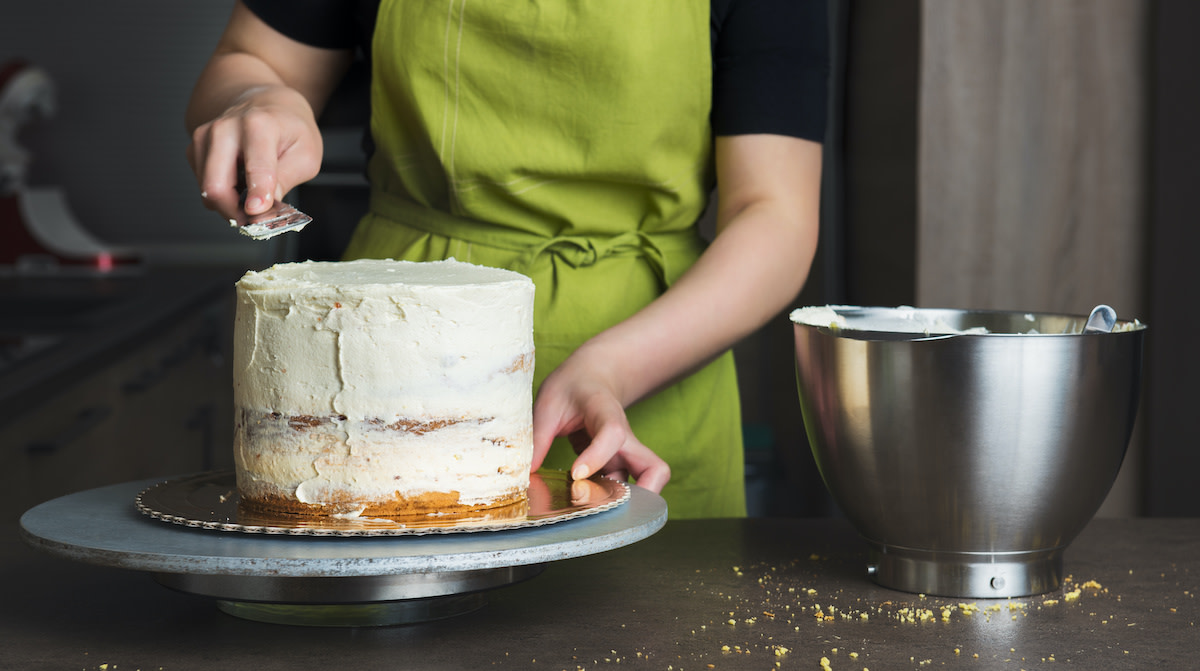How to Crumb Coat a Cake: 3 Tips for Crumb Coating
Written by MasterClass
Last updated: Dec 8, 2021 • 4 min read
Adding a crumb coat to a layer cake can help create a smooth, professional-looking cake. Follow this step-by-step tutorial to learn how to crumb coat a cake.
Learn From the Best
What Is a Crumb Coat?
A crumb coat is a thin layer of frosting that bakers apply to a layer cake before the final coat of frosting or fondant. A crumb coat keeps stray crumbs and cake pieces from coming loose during the cake decorating process. A crumb coat also fills in the gaps in the cake layers and gives the cake a uniform, smooth finish, making it easier to decorate the whole cake. A crumb coat is a primer for cake decoration and is essential to make the finished cake look clean and professional.
How to Crumb Coat a Cake
After you bake the cake layers, and they are cool enough to handle, follow these steps to crumb coat the cake:
- 1. Gather your materials. To crumb coat a cake, you need the cake layers, frosting, such as buttercream, an offset spatula, and a flat work surface to easily turn the cake. Many professional bakers use a cake turntable for this reason, though you can also use a flat plate, a cake stand, or a cake board. You can also have a bench scraper on hand to make sure you get a flat and smooth cake.
- 2. Frost the work surface. Put a tiny bit of buttercream on the work surface, then place the first cake layer on top of it to prevent the cake from moving around as you frost it.
- 3. Apply frosting to the bottom layer. Using your spatula, apply a thick layer of buttercream or frosting on top of the bottom cake layer, spreading the frosting from the center to the edge of the cake. Make sure not to touch the cake itself or run the risk of tearing the cake. Ensure the frosting is level.
- 4. Stack the cake layers. Stack the second layer of cake on top of the first cake layer, making sure the cake layers are level. Repeat the filling and stacking process until all of the cake layers are on top of each other.
- 5. Frost the top layer. Using your spatula, apply a dollop of frosting to the top of the cake, then spread the frosting out toward the edge of the cake, letting the excess frosting run down the side of the cake.
- 6. Spread frosting around the cake. Apply frosting on the side of the cake, spreading it thinly around the cake.
- 7. Smooth out the frosting. If you have a bench scraper, you can run it against the top of the cake and side while turning it. Every time you lift the bench scraper off the cake, scrape off the excess frosting and repeat the process until the cake is smooth. You can also smooth out the cake by pressing the flat side of a clean spatula down against the cake, running the spatula against the frosting. Scrape off the excess frosting before repeating the process.
- 8. Assess the crumb coat. If there are any uneven areas or gaps, cover them with more frosting, and smooth them with the bench scraper or spatula. The crumb coat should be very thin, and you should still be able to see the cake layers through the crumb coat.
- 9. Refrigerate the cake. After you finish crumb coating, refrigerate the whole cake. This will harden the crumb coat so it does not come loose in the final frosting and decorating process. You should chill the crumb coat for thirty minutes to an hour, however long it takes for the buttercream to harden. You can even crumb coat the cake one day and then do the final cake decorating the next day. While you wait for your crumb coat to harden, cover the buttercream with plastic wrap, so it doesn't crust over.
3 Tips for Crumb Coating a Cake
When crumb coating a cake, keep these tips in mind for best results:
- 1. Ensure the cake layers are completely cool. The cake layers need to be at room temperature before frosting the cake. If the cake layers are warm, they will melt the frosting. If you have time, you can even chill the cake layers before frosting them to lessen the risk of breaking or tearing the cake while frosting.
- 2. Level your cake layers. It is much easier to frost a flat cake, creating a more professional look. Cake pans can yield dome-shaped cake layers; just take a bread knife and cut off the dome parts of the cake to create a flat cake layer. You can also use a cake leveler tool.
- 3. Keep your crumb coat frosting separate. When you’re crumb coating, do not deposit the excess frosting into your main bowl of frosting; otherwise, you will get crumbs in your final layer of frosting. Scrape off the excess frosting into a second bowl.
Want to Learn More About Baking?
Become a better baker with the MasterClass Annual Membership. Gain access to exclusive video lessons taught by the world’s best, including Dominique Ansel, Joanne Chang, Gordon Ramsay, Chef Thomas Keller, Mashama Bailey, and more.
